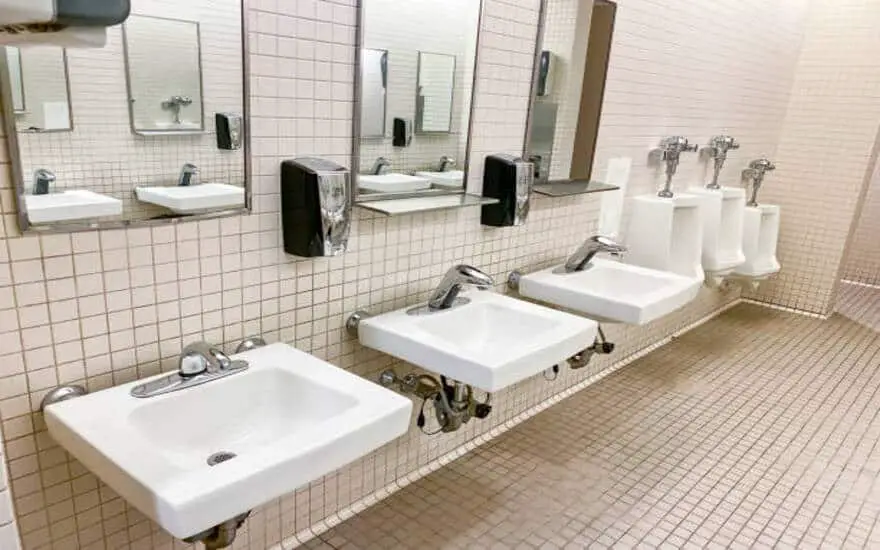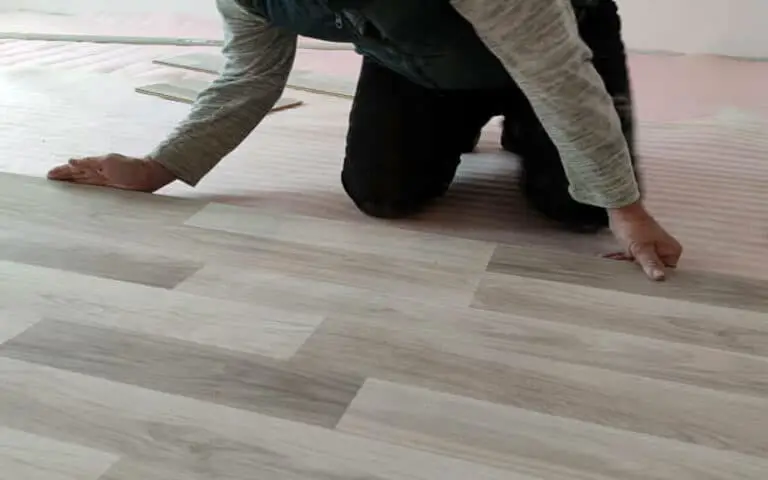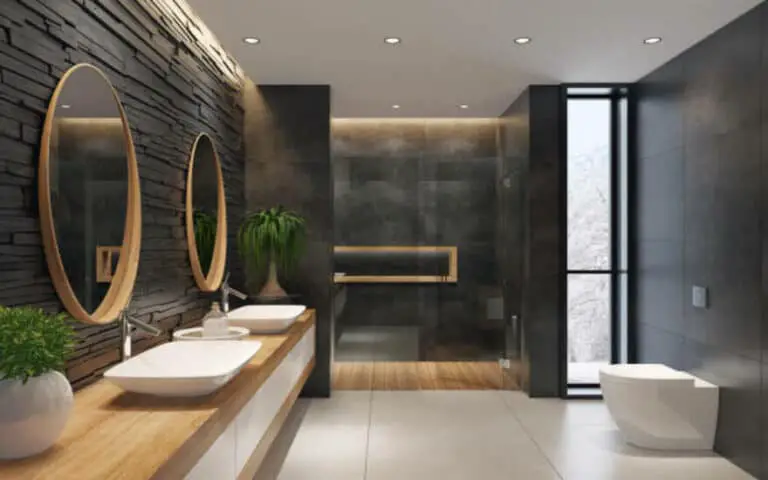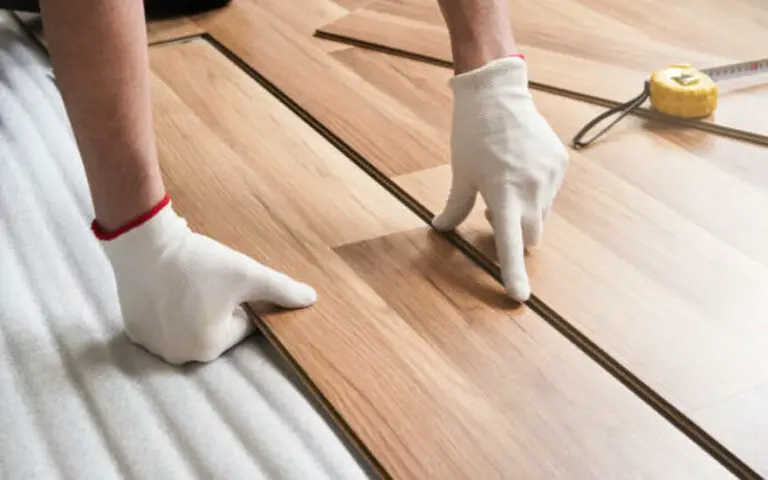In this blog post, I’ll discuss the best flooring options for hospitals and explain why they’re ideal for bathrooms in hospitals. Keep reading to learn more!

10 Benefits of Hospital Bathroom Flooring
Hospital bathroom flooring is essential in any healthcare setting, as it needs to be durable, hygienic, and slip-resistant to reduce the risk of injury. The right flooring can also create a comfortable and calming environment for patients and staff. Here are the benefits:
1. Durability
Durability is one of the main benefits of hospital bathroom flooring. Luxury Vinyl Tile (LVT) sheet vinyl, Flash Coved sheet vinyl, and Forbo Step flooring are all highly durable and designed to last for years with minimal maintenance.
This makes them great for busy healthcare facilities, where floors must withstand constant foot traffic and heavy equipment. Not only does this ensure that the flooring stays looking great for longer, but it can also help to reduce long-term costs, as there is no need to replace the flooring as often.
2. Easy to clean
One of the main benefits of hospital bathroom flooring is that it is incredibly easy to clean. This is crucial for preventing the spread of bacteria and other harmful pathogens, ensuring that the space remains hygienic and safe for both patients and staff.
Hospital bathroom flooring is designed to be non-porous, so dirt and liquid cannot penetrate the surface, making it much easier to keep clean. In addition, these surfaces are usually sealed with an antimicrobial coating which helps to prevent the buildup of bacteria and dirt.
Many types of hospital flooring also come with a textured finish, which helps reduce slips and trips and makes removing dirt and debris from the surface easier.
3. Hygienic and safe
Hygienic and safe bathroom flooring is essential for any healthcare facility. Hospital bathroom flooring must be durable, easy to clean, and slip-resistant to protect patients and staff. In addition, it should be made of materials that reduce the risk of contamination and help maintain a hygienic environment.
Luxury vinyl tile (LVT) and homogenous plastic flooring are two of the most popular choices for hospitals due to their outstanding sanitary qualities. Both types of flooring provide a waterproof, non-porous surface that minimizes the risk of cross-contamination.
Furthermore, these materials are designed to reduce noise levels, making them ideal for hospital settings. With exceptional durability and low maintenance requirements, these flooring options can help you save money in the long run by reducing replacement and repair costs.
Choosing the right hospital bathroom flooring can create a safe and hygienic environment for your patients and staff.
4. Slip-resistant surfaces
Slip-resistant surfaces are essential for any hospital bathroom flooring. With regular visitors, floors must be designed with a high level of grip to prevent slips or falls. Luxury Vinyl Tile (LVT) is a popular choice for hospital bathrooms as it offers an enhanced level of slip-resistance and is available in various designs and colors to suit any interior.
Forbo’s Step range also ensures a high level of slip resistance while maintaining a modern aesthetic. By investing in slip-resistant surfaces, you can ensure the safety and well-being of your visitors while also creating an aesthetically pleasing environment.
5. Reduced noise levels
Noise levels in healthcare facilities can disrupt both patients and staff, so it is important to choose flooring that reduces sound transmission. Hospital bathroom flooring made from luxury vinyl tile (LVT) is an ideal choice because it is a soft, resilient material that absorbs sound, keeping noise levels low and creating a more pleasant environment. Also, LVT flooring is slip-resistant and easy to clean, making it perfect for hospital bathrooms.
6. Minimized risk of contamination
Bathroom floors in healthcare facilities need to be safe and hygienic to minimize the risk of contamination. Seamless cast floors are ideal for this purpose, as they are 100% liquid-tight and can be easily cleaned. Luxury Vinyl Tile (LVT) sheet vinyl flooring is an excellent option for bathrooms in healthcare facilities due to its durability, slip resistance, and low maintenance requirements.
Forbo’s Step range is specially designed for showers and toilets, providing a modern design while reducing the risk of slips or falls. With careful installation, proper maintenance, and the right flooring choice, you can be sure that your hospital bathroom floors are safe and hygienic.
7. Long-term cost savings
The long-term cost savings that come with hospital bathroom flooring are significant. The durability of the flooring and its resistance to wear and tear means that you don’t have to replace or repair it as often as other types of flooring. Additionally, its easy-to-clean nature means you don’t have to invest in harsh cleaning products or services.
This, combined with its hygienic qualities, also reduces the risk of contamination and associated costs. In terms of maintenance, hospital bathroom flooring requires very little attention and can last for years with basic cleaning and polishing. Hospital bathroom flooring is an excellent choice if you’re looking for a cost-effective solution for your healthcare facility.
8. Low maintenance
Maintaining your hospital bathroom flooring is easy and cost-effective. Regular maintenance can keep your flooring looking new for years with the right cleaning products. Routine cleaning and maintenance can help prevent dirt and grime buildup, which can cause the floor to wear down faster.
For best results, use a gentle cleaning solution that won’t damage the foot, such as a mild detergent or soap and water. In addition to regular cleaning, you should seal and wax your hospital bathroom flooring regularly to help protect it from dirt and water damage. Sealing and waxing can also enhance the look of your flooring and make it last longer.
9. Enhanced aesthetics
Enhanced aesthetics is one of the major benefits of hospital bathroom flooring. Hospital bathrooms require attractive and practical floors, and hospital flooring can provide both. Hospital flooring can come in various colors, textures, and patterns, allowing you to customize the look of your bathroom while still ensuring it is safe and hygienic.
The right type of hospital flooring can also provide an inviting and comfortable atmosphere for patients, making them more likely to use the facilities and reducing the risk of accidents or falls. With the right hospital flooring, you can create a pleasant atmosphere that patients will appreciate and enjoy.
10. Improved patient experience
The most important benefit of hospital bathroom flooring is improving the patient experience. Hospital bathrooms can be stressful places for many people, especially those who are unwell. Having comfortable, safe, and hygienic flooring can help alleviate some of this stress and make the experience much more positive.
Additionally, the slip-resistant surfaces of hospital bathroom floors ensure that patients can safely move around the area without slipping or falling. This can be especially important for elderly or mobility-impaired patients who may require extra support.
Types of Hospital Flooring
Luxury Vinyl Tile (LVT) is a popular choice due to its durability, ease of cleaning, and slip-resistant surface. Sheet vinyl is also a great choice for hospital floors as it can be flash coved to create a seamless, liquid-tight surface. Other flooring types suitable for hospital bathrooms include bamboo wood, laminate, and homogenous plastic flooring.
Each type of flooring offers unique benefits and should be chosen depending on the specific needs of the healthcare facility.
Installing Hospital Flooring
Installing hospital flooring can be a complex process, but it can be relatively quick and easy with the right preparation and a reputable contractor. It is important to ensure that the flooring is installed correctly to maximize its performance and longevity.
The first step is to assess the condition of the existing floor and determine the best type of flooring for the environment. Once the type of flooring has been decided, the contractor will prepare the surface before installation.
This includes cleaning and repairing any damage and ensuring that any moisture issues have been addressed. Once the surface is ready, the flooring can be installed following the manufacturer’s instructions. Finally, the contractor will finish the job by sealing or polishing the floor, depending on the type of flooring chosen.
With proper installation and maintenance, hospital floors can provide a safe, hygienic, and aesthetically pleasing environment for patients and staff alike.
Maintenance Tips for Hospital Flooring
Maintenance Tips for Hospital Flooring
It is essential to properly maintain hospital bathroom flooring to keep it in good condition and ensure it remains safe, hygienic, and aesthetically pleasing. To safeguard your hospital bathroom flooring remains in top condition, here are some quick tips:
- Sweep and mop regularly – dirt and debris can affect the safety of the floor and build up over time, so it is important to keep it clean.
- Use the right cleaning products – never use harsh chemicals or abrasives on your hospital bathroom flooring, as this can damage the surface. Check the manufacturer’s instructions for the ideal cleaning products.
- Avoid dragging furniture or heavy items on the floor – this can cause scratches and damage to the flooring. If you need to move heavy objects, use furniture sliders or blankets to protect the surface.
- Use protective mats – using mats in areas where there will be a lot of foot traffic will help protect your hospital bathroom flooring from wear and tear.
- Fix any damage immediately – if you notice any damage to your hospital bathroom flooring, immediately prevent it from worsening. This could mean patching any rips or tears or replacing a floor section if needed.
Following these maintenance tips can help ensure your hospital bathroom flooring remains safe, hygienic, and attractive for years to come.
Summary
Choosing the right type of flooring for hospital bathrooms is important to ensure safety, comfort, and durability. Luxury vinyl tile, sheet vinyl, and rubber flooring are all good options that provide a range of benefits, including slip resistance, hygienic surfaces, low maintenance costs, and improved aesthetics.
When installing hospital bathroom flooring, it’s important to consider factors like the environment, traffic levels, and budget. Regular maintenance is also essential for keeping bathroom floors in good condition and safe for patients. With the right flooring and proper care, hospital bathrooms can be comfortable and hygienic places for patients.






